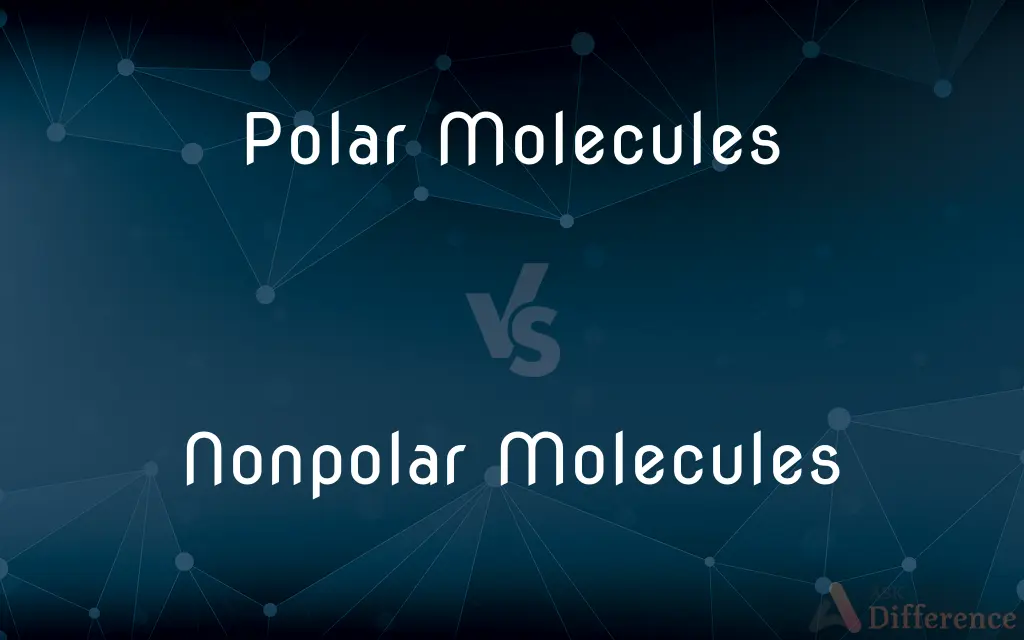Polar Molecules vs. Nonpolar Molecules — What's the Difference?
By Tayyaba Rehman — Published on December 8, 2023
Polar Molecules have uneven electron distribution leading to partial charges, whereas Nonpolar Molecules have even electron distribution with no partial charges.

Difference Between Polar Molecules and Nonpolar Molecules
Table of Contents
ADVERTISEMENT
Key Differences
Polar Molecules are characterized by an uneven distribution of electrons, resulting in a molecule with a positive end and a negative end. On the contrary, Nonpolar Molecules exhibit an even distribution of electrons, making the entire molecule neutral without distinct positive or negative ends.
The presence of polar bonds within a molecule often leads to the formation of Polar Molecules. However, just having polar bonds does not guarantee a polar molecule; the shape matters too. Nonpolar Molecules typically arise from nonpolar bonds or symmetrical arrangements of polar bonds that cancel out.
Interactions between Polar Molecules are generally stronger due to the presence of dipole-dipole forces. In contrast, Nonpolar Molecules primarily interact through weaker dispersion or London forces.
In a solution, Polar Molecules often dissolve in polar solvents due to the "like dissolves like" principle. On the other hand, Nonpolar Molecules are more soluble in nonpolar solvents.
Polar Molecules can exhibit properties like higher boiling points and melting points due to stronger intermolecular forces. Conversely, Nonpolar Molecules tend to have lower boiling and melting points because of their weaker forces of attraction.
ADVERTISEMENT
Comparison Chart
Electron Distribution
Uneven, leading to partial charges
Even, no partial charges
Types of Bonds
Polar bonds, or a mix if shape leads to polarity
Nonpolar bonds, or symmetrical polar bonds
Intermolecular Forces
Stronger (dipole-dipole forces)
Weaker (dispersion or London forces)
Solubility in Water
Generally soluble
Generally insoluble
Boiling/Melting Points
Typically higher due to stronger forces
Typically lower due to weaker forces
Compare with Definitions
Polar Molecules
Polar Molecules often result from polar bonds within an unsymmetrical shape.
Ammonia is a Polar Molecule because of its pyramidal structure and polar nitrogen-hydrogen bonds.
Nonpolar Molecules
Nonpolar Molecules have a symmetrical distribution of electron density.
Methane is a Nonpolar Molecule because of its tetrahedral symmetry.
Polar Molecules
Polar Molecules have stronger intermolecular attractions due to dipole-dipole forces.
Polar Molecules such as hydrogen chloride exhibit stronger attractions leading to higher boiling points.
Nonpolar Molecules
Nonpolar Molecules exhibit weaker forces of attraction.
Nonpolar Molecules like helium have very low boiling points due to weak intermolecular forces.
Polar Molecules
Polar Molecules possess distinct positive and negative ends.
The polarity in Polar Molecules like hydrogen fluoride results in a positive hydrogen end and a negative fluorine end.
Nonpolar Molecules
Nonpolar Molecules arise from nonpolar bonds or symmetrical polar bonds.
Carbon tetrachloride is a Nonpolar Molecule despite having polar bonds due to its symmetrical shape.
Polar Molecules
Polar Molecules have an asymmetrical distribution of electron density.
Water is one of the most common Polar Molecules due to its bent shape.
Nonpolar Molecules
Nonpolar Molecules lack distinct charged regions.
Oxygen (O2) is a Nonpolar Molecule as the electrons are evenly distributed.
Polar Molecules
Polar Molecules can interact with other polar compounds.
Polar Molecules like methanol can dissolve in water due to their mutual polarity.
Nonpolar Molecules
Nonpolar Molecules do not readily mix with polar compounds.
Oil is a Nonpolar Molecule and does not mix with water, a polar compound.
Common Curiosities
Polar Molecules or Nonpolar Molecules?
Polar Molecules generally have stronger intermolecular forces due to dipole-dipole attractions.
What are Polar Molecules?
Polar Molecules have uneven electron distribution, resulting in partial positive and negative ends.
Can a molecule with polar bonds be Nonpolar Molecules?
Yes, if the polar bonds are arranged symmetrically, their effects can cancel out, making the molecule nonpolar.
Why do Polar Molecules have higher boiling points?
Polar Molecules have stronger dipole-dipole attractions, requiring more energy to break, leading to higher boiling points.
Why don't Nonpolar Molecules mix well with polar solvents?
The intermolecular forces in Nonpolar Molecules are different from those in polar solvents, leading to poor solubility.
What causes the polarity in Polar Molecules?
Polarity in Polar Molecules arises from an uneven distribution of electrons due to differences in electronegativity or molecular shape.
Do Polar Molecules dissolve in water?
Typically, yes, because water is also polar, and "like dissolves like".
What characterizes Nonpolar Molecules?
Nonpolar Molecules have even electron distribution, making them neutral without distinct charged ends.
Are all molecules with nonpolar bonds Nonpolar Molecules?
Yes, molecules with only nonpolar bonds are always Nonpolar Molecules.
Is carbon dioxide a Polar Molecule or Nonpolar Molecule?
Carbon dioxide is a Nonpolar Molecule due to its linear symmetrical shape.
Can Polar Molecules conduct electricity?
Generally, in a liquid state, Polar Molecules don't conduct electricity unless they ionize.
How do Nonpolar Molecules interact with each other?
Nonpolar Molecules interact through weak dispersion or London forces.
Is water a Polar Molecule or Nonpolar Molecule?
Water is a Polar Molecule due to its bent shape and polar oxygen-hydrogen bonds.
How do Polar Molecules and Nonpolar Molecules behave in an electric field?
Polar Molecules align with the electric field, while Nonpolar Molecules remain unaffected.
Share Your Discovery

Previous Comparison
Cheesy vs. Sentimental
Next Comparison
Imax 3D vs. ImaxAuthor Spotlight
Written by
Tayyaba RehmanTayyaba Rehman is a distinguished writer, currently serving as a primary contributor to askdifference.com. As a researcher in semantics and etymology, Tayyaba's passion for the complexity of languages and their distinctions has found a perfect home on the platform. Tayyaba delves into the intricacies of language, distinguishing between commonly confused words and phrases, thereby providing clarity for readers worldwide.
















































